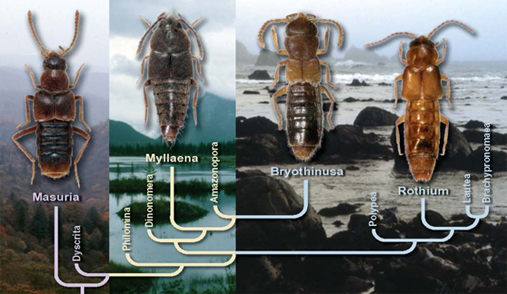A significant portion of the insect fauna of the coastal habitat is made up of beetles and the highest number of species belongs to the family Staphylinidae. At present, over 390 species in 93 genera and eight subfamilies (Microsilphinae, Omaliinae, Pselaphinae, Aleocharinae, Oxytelinae, Scydmaeninae, Paederinae, and Staphylininae) are known to be exclusively confined to coastal habitats. Coastal Staphylinidae are highly polyphyletic, and have diverse adaptations of structure, physiology, and behaviour. Multiple origins of coastal habitat colonization have occurred in the Staphylinidae. Aleocharinae contain the largest number of coastal species (185 species in 48 genera), almost half of all marine littoral staphylinids.
Today I would like to briefly introduce my research program on the diversity, phylogeny and habitat evolution of the coastal Staphylinidae. Four selected staphylinid lineages containing many coastal species published with my colleagues and students are provided. First, phylogeny of the tribe Myllaenini Ganglbauer and related genera is presented. Monophyly of the Myllaenini is tested, and the tribe is hypothesized to be a monophyletic group consisting of nine genera (Myllaena Erichson, Amazonopora Pace, Dimonomera Cameron, Bryothinusa Casey, Philomina Blackwelder, Polypea Fauvel, Brachypronomaea Sawada, Rothium Moore and Legner, and Lautaea Sawada), based on the synapomorphy of antero-lateral angles of mentum prolonged into spinose processes. The data set for phylogenetic analysis comprised 99 characters representing 297 character states derived from adult morphology. Coastal habitat evolution is represented by a single optimization of two origins. Ancestors of the Myllaenini appear to have arisen in riparian habitats and colonized coastal habitats
Second, phylogeny of the tribe Liparocephalini Fenyes is presented based on morphological and molecular characters. The data set comprised 50 adult morphological characters, partial COI (907 bp), COII (366 bp) and 12S rDNA (325-355 bp), and nearly complete sequences of 18S rDNA (1768-1902 bp) for 21 species. Eighteen species of liparocephaline beetles from all eight genera, and three outgroups are included. The DO tree for the combined data under equal weighting resulted in a monophyletic Liparocephalini with the following patterns of phylogenetic relationships (outgroup ((Baeostethus, Ianmoorea) (Paramblopusa ((Amblopusa, Halorhadinus) (Liparocephalus, Diaulota)))))). A sensitivity analysis using 16 different parameter sets for the combined data shows the monophyly of the liparocephalines and all of its genera under all parameter sets. Bayesian analysis resulted in topological differences in comparison to the DO tree under equal weighting only in the position of the genus Paramblopusa and clade (Amblopusa + Halorhadinus), which were reversed. The stepwise evolutionary colonization of intertidal habitat in the Liparocephalini is discussed and hypothesized that ancestors of the Liparocephalini appear to have arisen in the littoral zone of beaches and then colonized rocky reef areas in the low tidal zone later through high to mid tide zones.
Third, phylogeny of the marine littoral genus Cafius Stephens is presented based on molecular characters. The data set comprised partial mitochondrial COI (910 bp), COII (369 bp), 12S rDNA (351–354 bp), 16S rDNA (505–509 bp), and nearly complete sequences of 18S rDNA (1814–1830 bp) for 37 species. The genus Cafius and nearly all of its subgenera were not supported as being monophyletic. Instead, all analyses (parsimony trees, DO tree under equal weighting, and Bayesian tree) showed monophyly of Cafius + Phucobius + Remus + Thinocafius (clade Z) and all seven nested clades (A–G). However, the phylogenetic relationships among clades A–G differed among the analyses. The genus Phucobius was recovered as a monophyletic group within Cafius. The genus Remus was not monophyletic but formed a clade with C. rufescens Sharp and C. rufifrons Bierig within Cafius. The genus Thinocafius formed a clade with C. caviceps Broun, C. litoreus (Broun), and C. quadriimpressus (White) within Cafius. We propose new concepts for the genus Cafius and its related genera, and the seven nested clades.
Last, revised molecular phylogeny of the genus Aleochara Gravenhorst is presented. The data set comprised partial COI (1373 bp), COII (577 bp), and the complete sequences of tRNA leucine (71 bp) between them, for 56 Aleochara species and eight outgroups. We added 15 populations of eight coastal species [A. fucicola Sharp, A. littoralis (Mäklin), A. nubis Assing, A. puetzi Assing, A. squalithorax Sharp, A.sulcicollis Mannerheim, A. trisulcata Weise, and A. zerchei Assing]. All phylogenetic analyses strongly supported the monophyly of the genus Aleochara and four other clades (A–D) containing the coastal species. We hypothesize that there are four independent origins of specialization to a coastal habitat in the genus Aleochara (clades A–D). Clade A (Emplenota and Triochara), with nine species, is the most successful lineage in terms of species number and broad distribution range.
 Two origins of the coastal habitat in the Myllaenini. Ill.: Kee-Jeong Ahn
Two origins of the coastal habitat in the Myllaenini. Ill.: Kee-Jeong Ahn
